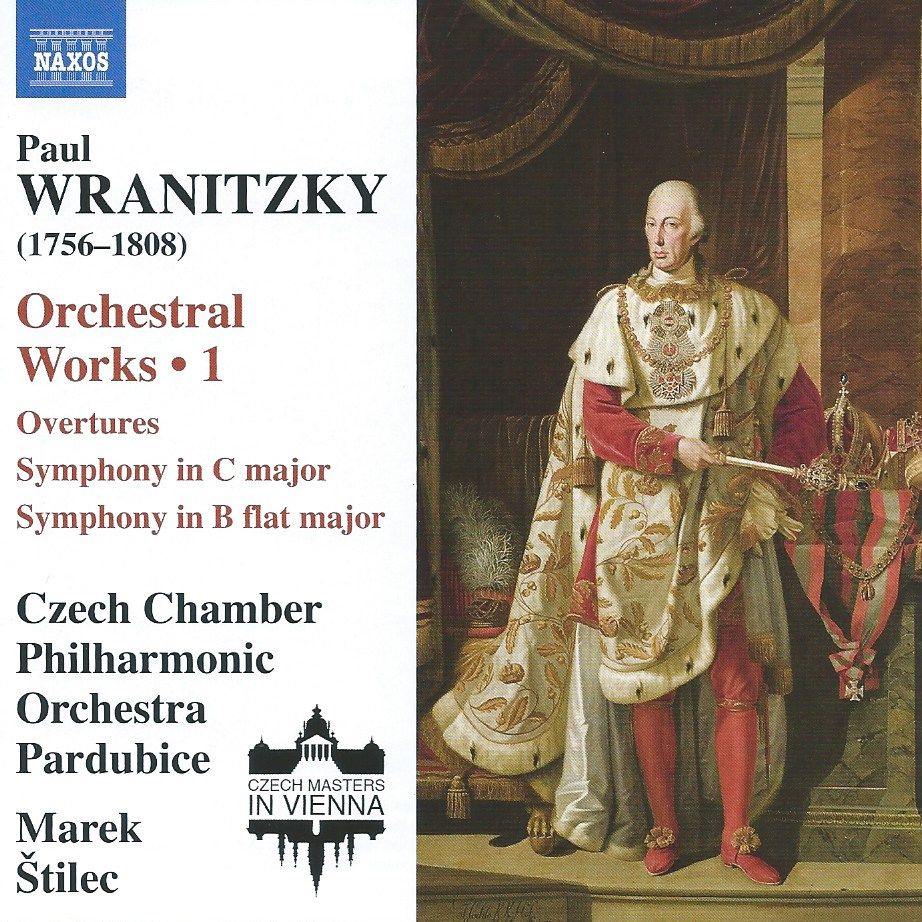The Music of Paul Wranitsky: Orchestral Works
Given Naxos' laudable penchant for completism, it is good to note that this is "Orchestral Works 1" ...

A sequence of World Premiere recordings here of music by the Czech-born contemporary of Mozart, Paul Wranitzky (1756-1808) here. The name may be known by some by Beethoven's sequence of Variations on a Russian Dance from "Das Waldmädchen". Let's hear that piece first of all, courtesy of Martino Tirimo from his box of the complete Beethoven piano works:
My own introduction to Wranitzky was via his works for wind. The composer's output was large, including around 13 operas (we have two overtures and a serenade from them on this Naxos disc) and around the same number of ballets: this specialist Wranitzky site gives a great overview of the composer and a sheaf of links to chase up.
After studies in Jíhlava and Olomouc, Wranitzky worked for a certain Count Esterhàzy; no, not that one, not Haydn's one, but a relative. Like Mozart, he was a member of a Viennese Masonic lodge, and when three lodges merged the two became known to one another; both composers unsurprisingly therefore had links to Emmanuel Schikaneder; in fact, it was Wranitzky's opera Oberon, König der Elfen that was the impetus for Schikaneder's series of fairy-tale operas that was to include Mozart's Die Zauberflöte.
At the turn of the 18th century, Wrantzky was a highly important symphonist in Vienna; and the symphony he wrote to mark the ascension to the throne of Franz II in 1792 is included here; or to give it its full, rather grandiose, title, Große Symphonie bei Gelegenheit der Erhelung Freanzens zum Deutschen Kaiser, or, as Naxos puts it, "Coronation". It is also known as "Der Kaiser". The previous Emperor had died after holding his post for a mere 17 months. Pomp (the opening Andante maestoso) meets overt, Persil-bright C major celebration in the first movement:
That brightness returns in the Menuetto after the lyrical (and not without shadows) Andante con moto. Let's revel in the Menuetto, and perhaps note the excellence of the Pardubice orchestra's solo oboe in the Trio:
All credit to the Czech Chamber Orchestra Pardubice for its sparkling finale, too. A magnificent performance of a signifcant work which all lovers of the Classical symphony should hear.
Wrantizky published three symphonies as his Op. 33 in 1798. The first of those, in B flat, is heard here, the first movement of J. C. Bach-like freshness. But it is the slow movement that will surely yield most pleassure, gallant, full of string-woodwind dialogue (and including a passage for muted horns):
Personally, that Adagio is the highlight of the disc for me, impeccably constructed, gloriously played. I do wonder if the Allegretto Menuetto isn't just a touch brisk for its marking, but Štilec's idea seems to be to create maximal contrast to the Trio - which itself seems to nring images of Lederhosen and the odd thigh slap. The bustling finale, though, is glorious.
The operatic pieces reveal another side of Wrantizky; a sort of Beethovenian whiff of grease-paint comes from the overture to the 1794 opera Der Poststation. Frankly the plot sounds like pure farce, and is probably all the better for it. The Overture certainly has plenty fo energy (and is it just me, or do I hear a pre-echo of the "Eroica" here?):
The excerpts from the 1794 opera Das Fest der Lazzaroni include not only the brief Overture but also a three-movement "Serenate". The Overture is descriptive (a storm in the Bay of Naples; you can't miss it):
The three movement "Serenade" comes from the second act, in which a suitor has hired a band of musicians to serenade a beloved. Sdaly the solo vilin in the first movement is not credited, but one assumes it is the leader of the Pardubice orchestra, Markéta Čepická.
Given Naxos' laudable penchant for completism, it is good to note that this is "Orchestral Works 1"; so there's lots more to come, and one hopes from the same source, too. The Czech orchestra has all of the plus points of orchestras from that region: a rounded but not heavy sound, superbly characterful wind, musicians with an innate musicality coupled with a real sense of discipline and, finally, true affection for the music.
In 2004, Naxos released a disc of a 27-minute Wranitzky Oboe Trio coupled with some rarely-heard Beethoven. And on this occasion, "oboe trio" means what it says on the tin - two oboes and a cor anglias (as opposed to oboe and two strings) . Here's the delightful finale of that piece to round off today's post:
